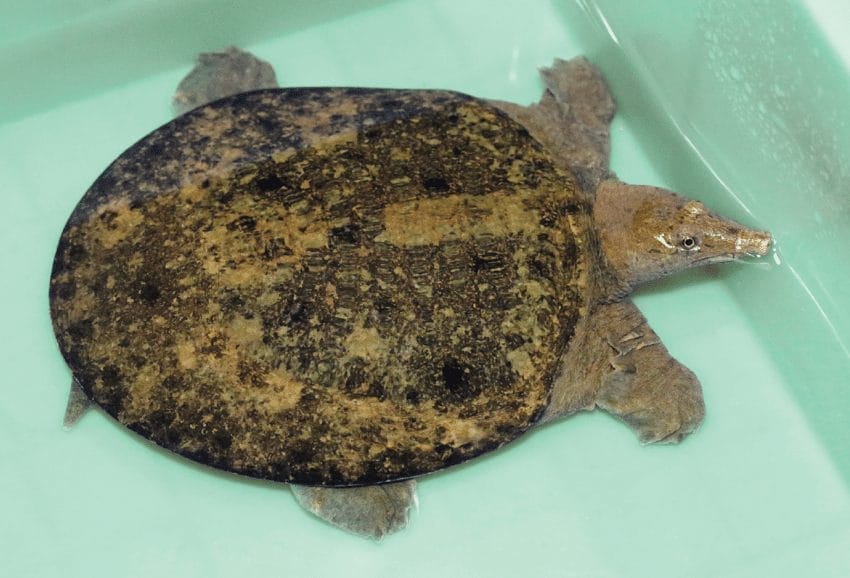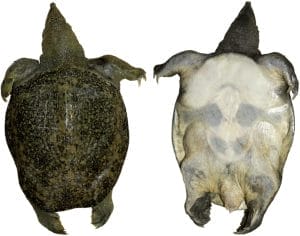Pelodiscus axenaria (Hunan Softshell Turtle)
Home > Turtle Database > Pelodiscus axenaria (Hunan Softshell Turtle)

Pelodiscus axenaria, also called the Hunan Softshell Turtle, is a rare freshwater turtle native to China. It’s known for its soft shell and secretive habits, making it a challenge to study in the wild.
Native To These Regions
Hunan (China)Native Turtle Species Map – Find Turtles by Region
Scientific Classification
Kingdom: Animalia
Phylum: Chordata
Class: Reptilia
Order: Testudines
Family: Trionychidae
Genus: Pelodiscus
Species: Pelodiscus axenaria
Common Names
Hunan Softshell Turtle
Axenaria Softshell Turtle
This Hilarious Turtle Book Might Know Your Pet Better Than You Do
Let’s be real—most turtle care guides feel like reading a textbook written by a sleep-deprived zookeeper.
This one’s not that.
Told from the snarky point of view of a grumpy, judgmental turtle, 21 Turtle Truths You’ll Never Read in a Care Guide is packed with sarcasm, sass, and surprisingly useful insights.
And hey—you don’t have to commit to the whole thing just yet.
Grab 2 free truths from the ebook and get a taste of what your turtle really thinks about your setup, your food choices, and that weird plastic palm tree.
It’s funny, it’s honest, and if you’ve ever owned a turtle who glares at you like you’re the problem—you’ll feel seen.
Identification
Description
This species has a flat, leathery shell that is olive to brown in color with dark markings. Like other softshell turtles, it lacks the hard scutes found in most turtles. It has a long neck and a pointed snout with wide-set eyes.
Sexual Dimorphism
Males are generally smaller and have longer, thicker tails. Females tend to be larger with shorter tails and broader shells.
Check more turtles from the Pelodiscus genus
Native Origin and Distribution
Geographical Range
Pelodiscus axenaria is native to Hunan Province in China, especially in the middle and upper parts of the Xiang River system. It has a very limited and localized distribution.
Preferred Habitat
This turtle prefers slow-moving freshwater habitats like streams, rivers, and ponds with sandy or muddy bottoms. It often buries itself in the substrate to hide or ambush prey.
Behavior
Feeding Habits
It is carnivorous and mainly eats aquatic invertebrates, small fish, amphibians, and insects. It’s an ambush predator, relying on quick strikes.
Predators
Juveniles are vulnerable to birds and large fish. Adults may fall prey to humans and occasionally to large mammals if caught on land.
Reproduction
Breeding Season
Breeding usually happens during spring and early summer, starting after the turtles emerge from hibernation.
Reproductive Method
Females lay eggs in sandy banks near water. The clutch size is small, and little is known about their incubation time due to the species’ rarity.
Conservation
Extinction Status
Classified as Not Evaluated.
Threats
The biggest threats include habitat destruction from dam construction, pollution, and illegal hunting for local consumption. Hybridization with other Pelodiscus species is also a concern.
Conservation Measures
China has placed some protections on this species, but enforcement is weak. There are calls for stricter habitat preservation and monitoring of wild populations.
Economic Importance
This species has little direct economic value compared to other softshell turtles used in Chinese markets. Still, it’s sometimes caught for meat, which adds pressure on its already small population.
Interesting Facts
Pelodiscus axenaria was only formally described in 1991, making it one of the more recently discovered softshell turtles.
Its narrow range and close resemblance to other Pelodiscus species make it easy to misidentify, which complicates conservation efforts.

About Author
Muntaseer Rahman started keeping pet turtles back in 2013. He also owns the largest Turtle & Tortoise Facebook community in Bangladesh. These days he is mostly active on Facebook.














